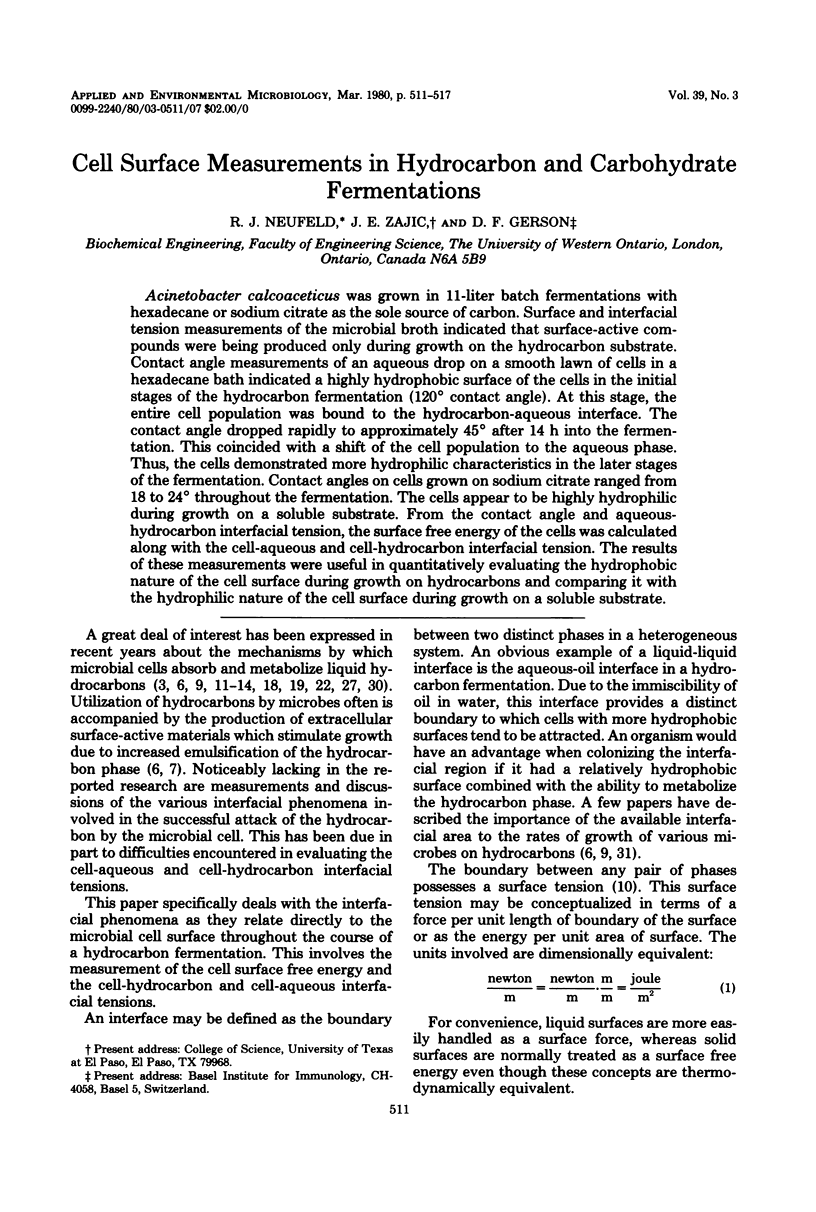Abstract
Acinetobacter calcoaceticus was grown in 11-liter batch fermentations with hexadecane or sodium citrate as the sole source of carbon. Surface and interfacial tension measurements of the microbial broth indicated that surface-active compounds were being produced only during growth on the hydrocarbon substrate. Contact angle measurements of an aqueous drop on a smooth lawn of cells in a hexadecane bath indicated a highly hydrophobic surface of the cells in the initial stages of the hydrocarbon fermentation (120° contact angle). At this stage, the entire cell population was bound to the hydrocarbon-aqueous interface. The contact angle dropped rapidly to approximately 45° after 14 h into the fermentation. This coincided with a shift of the cell population to the aqueous phase. Thus, the cells demonstrated more hydrophilic characteristics in the later stages of the fermentation. Contact angles on cells grown on sodium citrate ranged from 18 to 24° throughout the fermentation. The cells appear to be highly hydrophilic during growth on a soluble substrate. From the contact angle and aqueous-hydrocarbon interfacial tension, the surface free energy of the cells was calculated along with the cell-aqueous and cell-hydrocarbon interfacial tension. The results of these measurements were useful in quantitatively evaluating the hydrophobic nature of the cell surface during growth on hydrocarbons and comparing it with the hydrophilic nature of the cell surface during growth on a soluble substrate.
Full text
PDF






Selected References
These references are in PubMed. This may not be the complete list of references from this article.
- Gutierrez J. R., Erickson L. E. Hydrocarbon uptake in hydrocarbon fermentations. Biotechnol Bioeng. 1977 Sep;19(9):1331–1349. doi: 10.1002/bit.260190907. [DOI] [PubMed] [Google Scholar]
- Hug H., Blanch H. W., Fiechter A. The functional role of lipids in hydrocarbon assimilation. Biotechnol Bioeng. 1974 Jul;16(7):965–985. doi: 10.1002/bit.260160709. [DOI] [PubMed] [Google Scholar]
- Kaeppeli O., Fiechter A. The mode of interaction between the substrate and cell surface of the hydrocarbon-utilizing yeast Candida tropicalis. Biotechnol Bioeng. 1976 Jul;18(7):967–974. doi: 10.1002/bit.260180709. [DOI] [PubMed] [Google Scholar]
- Käppeli O., Müller M., Fiechter A. Chemical and structural alterations at the cell surface of Candida tropicalis, induced by hydrocarbon substrate. J Bacteriol. 1978 Feb;133(2):952–958. doi: 10.1128/jb.133.2.952-958.1978. [DOI] [PMC free article] [PubMed] [Google Scholar]
- Marshall K. C., Cruickshank R. H. Cell surface hydrophobicity and the orientation of certain bacteria at interfaces. Arch Mikrobiol. 1973 Apr 8;91(1):29–40. doi: 10.1007/BF00409536. [DOI] [PubMed] [Google Scholar]
- Miura Y., Okazaki M., Hamada S. I., Murakawa S. I., Yugen R. Assimilation of liquid hydrocarbon by microorganisms. I. Mechanism of hydrocarbon uptake. Biotechnol Bioeng. 1977 May;19(5):701–714. doi: 10.1002/bit.260190507. [DOI] [PubMed] [Google Scholar]
- Nakahara T., Erickson L. E., Gutierrez J. R. Characteristics of hydrocarbon uptake in cultures with two liquid phases. Biotechnol Bioeng. 1977 Jan;19(1):9–25. doi: 10.1002/bit.260190103. [DOI] [PubMed] [Google Scholar]
- Reed G. B., Rice C. E. The Behaviour of Acid-fast Bacteria in Oil and Water Systems. J Bacteriol. 1931 Oct;22(4):239–247. doi: 10.1128/jb.22.4.239-247.1931. [DOI] [PMC free article] [PubMed] [Google Scholar]
- Scott C. C., Finnerty W. R. Characterization of intracytoplasmic hydrocarbon inclusions from the hydrocarbon-oxidizing Acinetobacter species HO1-N. J Bacteriol. 1976 Jul;127(1):481–489. doi: 10.1128/jb.127.1.481-489.1976. [DOI] [PMC free article] [PubMed] [Google Scholar]


